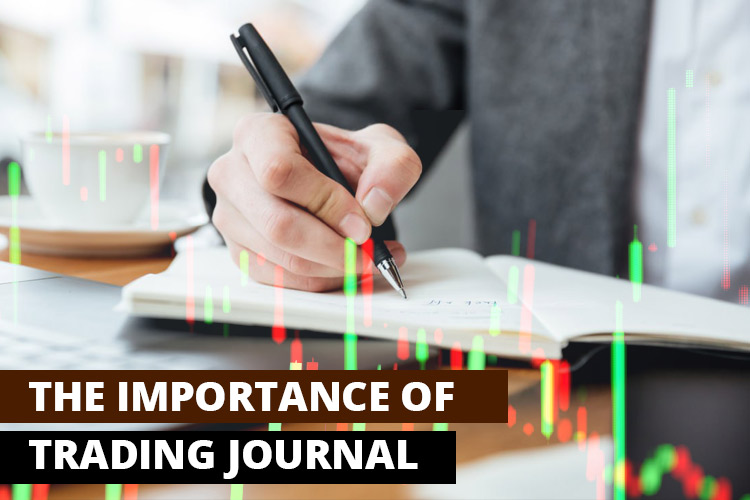A forex trading journal is needed to improve the effectiveness of your trades. How to build a good journal? Let's learn together!

No matter how experienced you are in forex trading, it is always important to learn from your previous trades. Evaluating is one of the ways to achieve better trading in the future. For this purpose, you need to compose a forex trading journal. It may be a difficult task to do, but if you are consistent enough, you will have an organized trading journal that can be used to evaluate your trading routines.
Here is an example of a forex trading journal and its components:
- Day: The day of the trade.
- Date: The date of the trade.
- Entry time: The time of the trade opened.
- Entry price: The level at which the trade is started.
- Setup: The trading signal and confirmation used to place the trade.
- Currency pair: The currency pair used.
- Stop Loss: The level at which the loss is limited.
- Profit target: The level at which the profit is targeted.
- The capital amount used: The amount of capital used.
- Trading volume: The amount of lot used.
- Exit price: The level at which the trade is ended.
- Exit time: The time of the trade closed.
- Profit/Loss: The total profit or loss gained.
- Pips Achievement: The number of pips earned/lost.
- Note: Extra information, usually related to psychological factors.
Aspects from 'Day' to 'Trading volume' are completed once you open or enter a trade. Meanwhile, the 'Exit price' to 'Note' is completed after you close the position. A forex trading journal is arranged on an MS Excel spreadsheet or a notebook. You can also save the screenshot of the price setting and indicator setups as additional information.
In general, a forex trading journal is an output of 3 trading plan components: the trading system, money management, and psychological management. Therefore, the trading journal should consist of a summary of those things in detail.
3 Key Factors of a Trading Journal
Everyone has different styles in composing their forex trading journal. So, no need to worry if other traders do not conduct the same method as you. You can either make use of the data components above or modify them by yourself. There is no standard as the journal is for your own use. Make it as simple as possible is probably the only recommended tips relevant to all traders. If you still need a guide to make a forex trading journal, here are the steps:
1. Include the Two Important Things
There will be more variations in composing journal points, but there are two important points that you cannot miss in composing the trading journal. They are Entry/Exit prices and Profit/Loss gained.
2. Make It Simple
Make your forex trading journal as simple as possible. This point is quite significant, especially for the new traders who just start to trade. With a simple journal, you can note down any development and re-read the trading journal easier.
3. Jot Down Additional Notes
Make sure to include the blank part for noting down the additional information. For instance, what factors motivated you to make a trade, what indicators used in trading (Moving Average, Stochastics, Relative Strength Index, or others), how is the market situation (ranging, trending, or breakout), and other information that might be useful when you review the previous trading positions.
How to Evaluate a Forex Trading Journal?
After opening some trading positions, you can summarize the complete information about your habit in trading and how you respond to the price movement. Then, simply evaluate the forex trading journal by figuring out what makes your trades work and keep doing it. Next, find out the factors that cause the failure and try to prevent it on the next trades.
How to decide whether the journal is helpful for your trading? You can classify the data into smaller categories such as the classifications based on the days, currency pairs, and so forth. If it is divided into smaller groups, you may obtain many variables that can be analyzed and developed.
Afterward, you can start to evaluate your journal by arranging some critical questions from the journal:
1. The Trading Time Category
The questions in this category relate to things related to trading time. Based on the questions, you can derive a conclusion of when is the best time to earn money from the market.
- Does this position earn equal profit in a week? Or is it only profitable on certain days? If so, on what days are they?
- Does the position cause equal losses in a week? Or does it only happen on certain days? If so, on what days are they?
- What is the average time to hold the trading position until the Take Profit is reached?
- What is the average time to hold the trading position until the Stop Loss is reached?
- What is your conclusion based on this time analysis?
- What can you develop from the forex trading journal based on this time evaluation?
2. The Currency Pair and Money Management Category
In trading, money management is one of the most important elements to face uncertainties in the forex market. A good trading strategy is not enough if your money management is not set properly.
The questions for the currency pair and money management evaluation include:
- Does this position earn equal profit in various currency pairs? Or is it only profitable in certain pairs? If yes, what pairs?
- Does this position earn equal loss in various currency pairs? Or is it only profitable in certain pairs? If yes, what pairs?
- How much is the average of the Take Profit used?
- How much is the average of the Stop Loss used?
- How much is the percentage of positions successfully closed with the Take Profit?
- How much is the percentage of positions successfully closed with the Stop Loss?
- How much is the Risk/Reward Ratio that earns more profit?
- How much is the total of profit at the moment?
- What can you conclude from the analysis of the currency pair and the money management?
- What can you develop from the evaluation based on the money management?
3. The Trading System Category
The questions in this category deal with the error that happened in the trading system. Most of them focus on the discipline of running the trading system. The questions are:
-
Have you stayed discipline in following the trading setup?
- If you haven't, how many positions are placed without following the trading setup?
- If you have, how is the profit/loss ratio?
- Is there any part of the trading system that has been developed?
- Should the whole system be shuffled totally and changed into a new one?
Without classifying and analyzing the forex trading journal into small categories, it will be difficult for you to build the knowledge, conclusion, and actions needed to improve your trading performance. You can classify and analyze such a way after completing your forex trading journal in a certain period of time.
Furthermore, composing the forex trading journal can improve your confidence level while trading. You can also attach the forex trading journal on your trading profile as a killing weapon should you plan to attract investors in the future.
Why is Evaluating Forex Trading Journal Important?
When you review your trading journal, you may be impressed by how good or bad is your journey as a trader. Besides reflecting on your previous trades, the journal also monitors your successful traits as a trader. As a result, you will be more effective in trading.
Do the transactions, note down your trading, and keep it for future evaluation. It is always beneficial to write down your transactions in the journal. By writing down all of them in the journal, you practically help yourself. Furthermore, the trading journal can help you repair your mistakes and weaknesses in the past. It's because the forex trading journal is a complete history of your transactions, so it is the best tool for evaluating your trading performance as a whole.
A basic forex journal trading does not need to be detailed. What's important is you can input crucial things before, during, and after the trades and review them for improvements.
MetaTrader 4 actually offers a special feature to record all of the results of your transaction. The journal of MT4 is an accomplished feature because it covers various data under the Detailed Statement. Nearly, all brokers offer MT4 in their service, so it is very accessible to traders all around the world. Also, there are certain MT4 tricks to increase your trading performance.

 Dedicated FREE FOREX VPS
Dedicated FREE FOREX VPS Free FOREX Virtual Private Server
Free FOREX Virtual Private Server MT4 Demo Contest, Get $500
MT4 Demo Contest, Get $500 Sign Up for an Account, Claim 60% Deposit Bonus
Sign Up for an Account, Claim 60% Deposit Bonus Free MT4/MT5 VPS 2024
Free MT4/MT5 VPS 2024 Send E-mail and Get Free Merchandise
Send E-mail and Get Free Merchandise $1K Refer a Friend Bonus for Pepperstone Pro clients
$1K Refer a Friend Bonus for Pepperstone Pro clients Maximize Your Earnings with 100% Deposit bonus
Maximize Your Earnings with 100% Deposit bonus Trade to Win, $5,000 Monthly Demo Contest
Trade to Win, $5,000 Monthly Demo Contest Claim 30% + 15% Deposit Bonus from LiteFinance
Claim 30% + 15% Deposit Bonus from LiteFinance













2 Comments
David
Mar 20 2024
Before delving into journal trading, I'd like to delve deeper into the trading time category that requires evaluation. Specifically, I'm interested in determining the optimal time for trading, particularly when dealing with the USD/JPY currency pair. It's crucial for me to ensure that I'm trading during the most opportune time frames. Appreciate any insights you can provide! Thanks.
Irfan
Mar 22 2024
Hey there! When it comes to trading the USD/JPY currency pair, identifying the best trading times can significantly impact your success in the market. While there isn't a one-size-fits-all answer to the question of the best trading time, there are certain periods that tend to exhibit higher volatility and trading activity, which can present more trading opportunities.
Typically, the USD/JPY pair experiences heightened activity during the overlap of the trading sessions of the United States and Japan. This occurs during the late Asian session and the early European session, roughly between 12:00 AM and 4:00 AM GMT. During this time, traders often witness increased liquidity and volatility, making it an optimal time for trading the USD/JPY pair. (you can read more about trading time in here : When is the Best Time to Trade Forex?)